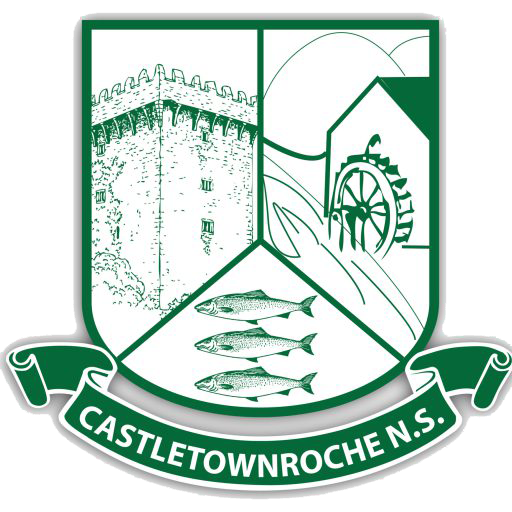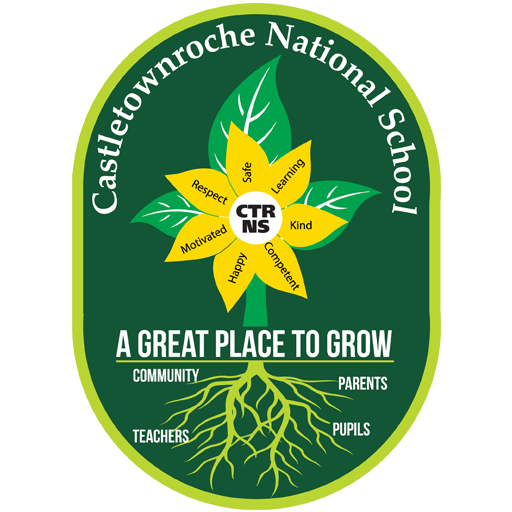Healthy Living
Healthy Living
Our aim in Castletownroche National School is to lay the foundations for life-long healthy eating.
We participate in the “Food Dudes” programme to inspire children to eat fruit and vegetables and encourage children to become more aware of the need for healthy food in their lunch boxes.
A healthy lunch box includes a piece of food from each of the first four shelves of the food pyramid.
Suggestions include:
- Bread, rolls, scones, pitta bread, tortillas, pancakes, crackers, crispbread, wheaten or soda bread, plain rice cakes.
- Fillings such as ham, cheese, salad, chicken, tuna or peanut butter.
- Fruit/vegetables such as apples, oranges, grapes, pears, bananas, raisins, raw carrot or raw celery sticks.
Friday is our treat day. On this day we can include one treat size piece of food from the top shelf of the pyramid.
Also, Castletownroche NS is a “Nut Product Free Zone” due to allergies in the school.
Health Information
Chickenpox
Caused by the varicella-zoster virus (VZV), chickenpox used to be a common illness among kids in the United States (particularly among those under age 12). An itchy rash of spots that look like blisters can appear all over the body and be accompanied by flu-like symptoms. Chickenpox is very contagious, so an infected child should stay home and rest until the rash is gone.
Symptoms
Chickenpox often starts with a fever, headache, sore throat, or stomach ache. These symptoms may last for a few days, with fever in the 101°-102°F (38.3°-38.8°C) range.
Chickenpox causes a red, itchy skin rash that usually appears first on the abdomen or back and face, and then spreads to almost everywhere else on the body, including the scalp, mouth, arms, legs, and genitals.
The rash begins as multiple small red bumps that look like pimples or insect bites, usually less than a quarter of an inch wide. They appear in crops over 2 to 4 days and develop into thin-walled blisters filled with fluid. The blister walls break, leaving open sores, which finally crust over to become dry, brown scabs. The rash is very itchy, and cool baths or calamine lotion may help to manage the itching.
A hallmark of chickenpox is that all stages (red bumps, blisters, and scabs) can appear on the body at the same time. The rash may be more extensive or severe in kids who have skin disorders like eczema, or weak immune systems. Young kids tend to have a mild illness with fewer blisters than older children or adults.
In rare cases, serious bacterial infections involving the skin, lungs, bones, joints, and the brain can occur.
Head Lice
Head lice are tiny wingless insects that are grey-brown in colour. They are the size of a pinhead when they hatch and 3mm long (the size of a sesame seed) when fully grown.
Head lice cannot fly, jump or swim. They are spread by head-to-head contact and climb from the hair of an infected person to the hair of someone else.
Life cycle of head lice
A female head louse lays eggs by cementing them to hairs (often close to the root) where they will be kept warm by the scalp. The eggs are pinhead size and difficult to see.
When the baby lice hatch 7 to 10 days later, the empty eggshells (nits) remain glued in place. Nits glisten white and become more noticeable as the growth of the hair carries them away from the scalp.
Head lice feed by biting the scalp and sucking blood through it. They take 6 to 10 days to become fully grown. Once mature, a head louse can transfer from head to head.
After mating, a female may start to lay eggs as early as the seventh day after she has hatched. So to break the life cycle and stop head lice spreading, they need to be removed from the head before the sixth day after hatching.
Getting rid of head lice
Head lice can be effectively treated using medicated lotions or by wet combing, using a specially designed head lice comb.
Always seek advice from a healthcare professional before using medicated head lice lotions on the following groups:
- young babies (under six months old)
- pregnant women
- people with asthma or allergies
Always read the instructions carefully before using medicated head lice lotions.
There is no need to wash or fumigate clothing or bedding that comes into contact with head lice.
Head lice can only survive on humans and they die after a day or two of being away from the human scalp.
Head lice that fall off the scalp are likely to be close to death (their life span is about three weeks).
Hand washing
Washing your hands is extremely important in order to keep healthy. Children need to be taught to cover their nose and mouth with tissues when they sneeze or cough, or to cough into their upper sleeve or elbow.
Children should wash their hands before:
- eating or handling food;
- playing with play dough; and
- playing in water.
Children should wash their hands after:
- using the toilet;
- eating;
- sneezing or coughing into their hands or blowing their nose;
- playing outdoors, in the sand, with play dough or in water;
- handling pets or animals;
- attending school; and
- spending time in indoor play areas
Four steps to proper hand washing
- Wet your hands under running water.
- Scrub your hands well with soap. Remember to scrub between your fingers, to wash both the front and back of your hands, and to clean under your finger nails.
- Washing your hands should take about 15 to 20 seconds – about the time it takes to sing “Happy Birthday”.
- Rinse your hands under running water.
- Dry your hands with a clean towel or hand dryer.

